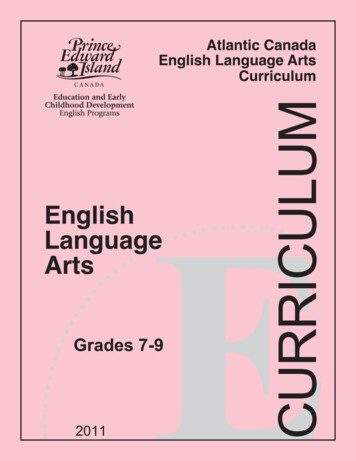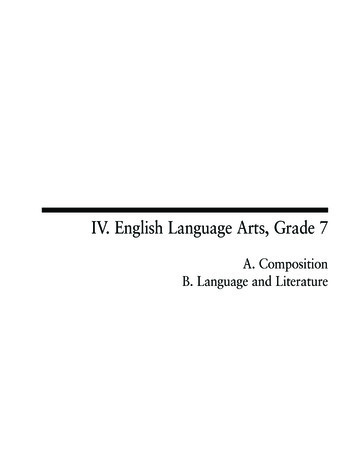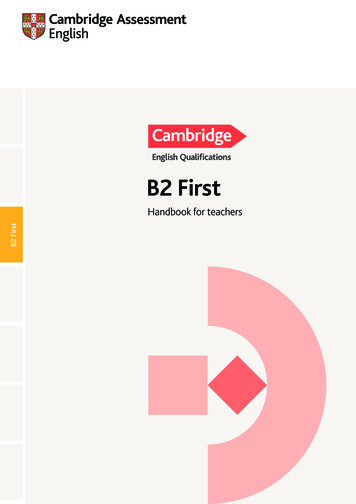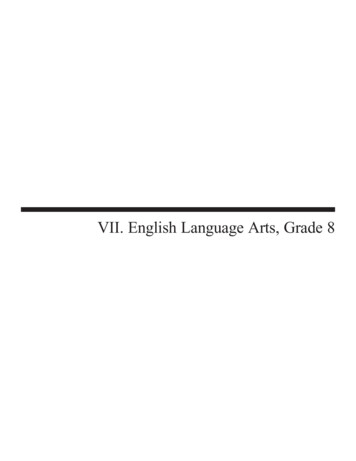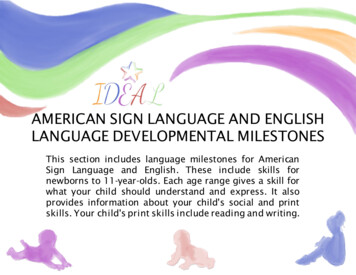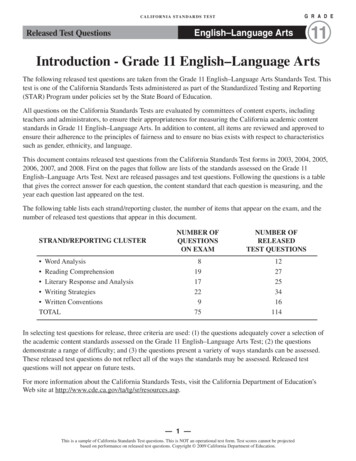
Transcription
G R A D ECA L I F O R N I A S TA N DA R D S T E S TEnglish–Language ArtsReleased Test Questions11Introduction - Grade 11 English–Language ArtsThe following released test questions are taken from the Grade 11 English–Language Arts Standards Test. Thistest is one of the California Standards Tests administered as part of the Standardized Testing and Reporting(STAR) Program under policies set by the State Board of Education.All questions on the California Standards Tests are evaluated by committees of content experts, includingteachers and administrators, to ensure their appropriateness for measuring the California academic contentstandards in Grade 11 English–Language Arts. In addition to content, all items are reviewed and approved toensure their adherence to the principles of fairness and to ensure no bias exists with respect to characteristicssuch as gender, ethnicity, and language.This document contains released test questions from the California Standards Test forms in 2003, 2004, 2005,2006, 2007, and 2008. First on the pages that follow are lists of the standards assessed on the Grade 11English–Language Arts Test. Next are released passages and test questions. Following the questions is a tablethat gives the correct answer for each question, the content standard that each question is measuring, and theyear each question last appeared on the test.The following table lists each strand/reporting cluster, the number of items that appear on the exam, and thenumber of released test questions that appear in this document.STRAND/REPORTING CLUSTERNUMBER OFQUESTIONSON EXAMNUMBER OFRELEASEDTEST QUESTIONS81917229751227253416114 Word Analysis Reading Comprehension Literary Response and Analysis Writing Strategies Written ConventionsTOTALIn selecting test questions for release, three criteria are used: (1) the questions adequately cover a selection ofthe academic content standards assessed on the Grade 11 English–Language Arts Test; (2) the questionsdemonstrate a range of difficulty; and (3) the questions present a variety of ways standards can be assessed.These released test questions do not reflect all of the ways the standards may be assessed. Released testquestions will not appear on future tests.For more information about the California Standards Tests, visit the California Department of Education’sWeb site at http://www.cde.ca.gov/ta/tg/sr/resources.asp.— 1 —This is a sample of California Standards Test questions. This is NOT an operational test form. Test scores cannot be projectedbased on performance on released test questions. Copyright 2009 California Department of Education.
G R A D ECA L I F O R N I A S TA N DA R D S T E S T11English–Language ArtsReleased Test QuestionsREADINGThe Reading portion of the Grade 11 California English–Language Arts Standards Test has three strands/reporting clusters: Word Analysis, Reading Comprehension, and Literary Response and Analysis. Each ofthese strands/clusters is described below.The Word Analysis Strand/ClusterThe following three California English–Language Arts content standards are included in the Word Analysisstrand/cluster and are represented in this booklet by 12 test questions for grade 11. These questionsrepresent only some ways in which these standards may be assessed on the Grade 11 California English–Language Arts Standards Test.11RW1.0WORD ANALYSIS, FLUENCY, AND SYSTEMATIC VOCABULARY DEVELOPMENT:Students apply their knowledge of word origins to determine the meaning of newwords encountered in reading materials and use those words accurately.11RW1.1Vocabulary and Concept Development: Trace the etymology of significant terms used inpolitical science and history.11RW1.2Vocabulary and Concept Development: Apply knowledge of Greek, Latin, and AngloSaxon roots and affixes to draw inferences concerning the meaning of scientific andmathematical terminology.11RW1.3Vocabulary and Concept Development: Discern the meaning of analogies encountered,analyzing specific comparisons as well as relationships and inferences.— 2 —This is a sample of California Standards Test questions. This is NOT an operational test form. Test scores cannot be projectedbased on performance on released test questions. Copyright 2009 California Department of Education.
CA L I F O R N I A S TA N DA R D S T E S TEnglish–Language ArtsReleased Test QuestionsG R A D E11The Reading Comprehension Strand/ClusterThe following six California English–Language Arts content standards are included in the ReadingComprehension strand/cluster and are represented in this booklet by 27 test questions for grade 11. Thesequestions represent only some ways in which these standards may be assessed on the Grade 11 CaliforniaEnglish–Language Arts Standards Test.11RC2.0READING COMPREHENSION (FOCUS ON INFORMATIONAL MATERIALS): Studentsread and understand grade-level-appropriate material. They analyze theorganizational patterns, arguments, and positions advanced. The selections inRecommended Readings in Literature, Grades Nine Through Twelve illustrate thequality and complexity of the materials to be read by students. In addition, by gradetwelve, students read two million words annually on their own, including a widevariety of classic and contemporary literature, magazines, newspapers, and onlineinformation.11RC2.1Structural Features of Informational Materials: Analyze both the features and therhetorical devices of different types of public documents (e.g., policy statements, speeches,debates, platforms) and the way in which authors use those features and devices.11RC2.2Comprehension and Analysis of Grade-Level-Appropriate Text: Analyze the way inwhich clarity of meaning is affected by the patterns of organization, hierarchical structures,repetition of the main ideas, syntax, and word choice in the text.11RC2.3Comprehension and Analysis of Grade-Level-Appropriate Text: Verify and clarify factspresented in other types of expository texts by using a variety of consumer, workplace, andpublic documents.11RC2.4Comprehension and Analysis of Grade-Level-Appropriate Text: Make warranted andreasonable assertions about the author’s arguments by using elements of the text todefend and clarify interpretations.11RC2.5Comprehension and Analysis of Grade-Level-Appropriate Text: Analyze an author’simplicit and explicit philosophical assumptions and beliefs about a subject.11RC2.6Expository Critique: Critique the power, validity, and truthfulness of arguments set forth inpublic documents; their appeal to both friendly and hostile audiences; and the extent towhich the arguments anticipate and address reader concerns and counterclaims (e.g.,appeal to reason, to authority, to pathos and emotion).— 3 —This is a sample of California Standards Test questions. This is NOT an operational test form. Test scores cannot be projectedbased on performance on released test questions. Copyright 2009 California Department of Education.
G R A D E11CA L I F O R N I A S TA N DA R D S T E S TEnglish–Language ArtsReleased Test QuestionsThe Literary Response and Analysis Strand/ClusterThe following eight California English–Language Arts content standards are included in the Literary Responseand Analysis strand/cluster and are represented in this booklet by 25 test questions for grade 11. Thesequestions represent only some ways in which these standards may be assessed on the Grade 11 CaliforniaEnglish–Language Arts Standards Test.11RL3.0LITERARY RESPONSE AND ANALYSIS: Students read and respond to historically orculturally significant works of literature that reflect and enhance their studies ofhistory and social science. They conduct in-depth analyses of recurrent themes. Theselections in Recommended Readings in Literature, Grades Nine Through Twelveillustrate the quality and complexity of the materials to be read by students.11RL3.1Structural Features of Literature: Analyze characteristics of subgenres (e.g., satire,parody, allegory, pastoral) that are used in poetry, prose, plays, novels, short stories,essays, and other basic genres.11RL3.2Narrative Analysis of Grade-Level-Appropriate Text: Analyze the way in which thetheme or meaning of a selection represents a view or comment on life, using textualevidence to support the claim.11RL3.3Narrative Analysis of Grade-Level-Appropriate Text: Analyze the ways in which irony,tone, mood, the author’s style, and the “sound” of language achieve specific rhetorical oraesthetic purposes or both.11RL3.4Narrative Analysis of Grade-Level-Appropriate Text: Analyze ways in which poets useimagery, personification, figures of speech, and sounds to evoke readers’ emotions.11RL3.5Narrative Analysis of Grade-Level-Appropriate Text: Analyze recognized works ofAmerican literature representing a variety of genres and traditions:1) Trace the development of American literature from the colonial period forward.2) Contrast the major periods, themes, styles, and trends and describe how works bymembers of different cultures relate to one another in each period.3) Evaluate the philosophical, political, religious, ethical, and social influences of thehistorical period that shaped the characters, plots, and settings.11RL3.6Narrative Analysis of Grade-Level-Appropriate Text: Analyze the way in which authorsthrough the centuries have used archetypes drawn from myth and tradition in literature,film, political speeches, and religious writings (e.g., how the archetypes of banishment froman ideal world may be used to interpret Shakespeare’s tragedy Macbeth).11RL3.8Literary Criticism: Analyze the clarity and consistency of political assumptions in aselection of literary works or essays on a topic (e.g., suffrage, women’s role in organizedlabor) (Political approach).11RL3.9Literary Criticism: Analyze the philosophical arguments presented in literary works todetermine whether the authors’ positions have contributed to the quality of each work andthe credibility of the characters (Philosophical approach).— 4 —This is a sample of California Standards Test questions. This is NOT an operational test form. Test scores cannot be projectedbased on performance on released test questions. Copyright 2009 California Department of Education.
CA L I F O R N I A S TA N DA R D S T E S TEnglish–Language ArtsReleased Test QuestionsG R A D E11WRITINGThe Writing portion of the Grade 11 California English–Language Arts Standards Test has two strands/reporting clusters: Writing Strategies and Written Conventions. Each of these strands/clusters is describedbelow.The Writing Strategies Strand/ClusterThe following seven California English–Language Arts content standards are included in the Writing Strategiesstrand/cluster and are represented in this booklet by 34 test questions for grade 11. These questions represent onlysome ways in which these standards may be assessed on the Grade 11 California English–Language ArtsStandards Test.11WS1.0WRITING STRATEGIES: Students write coherent and focused texts that convey awell-defined perspective and tightly reasoned argument. The writing demonstratesstudents’ awareness of the audience and purpose and progression through thestages of the writing process.11WS1.1Organization and Focus: Demonstrate an understanding of the elements of discourse(e.g., purpose, speaker, audience, form) when completing narrative, expository, persuasive,or descriptive writing assignments.11WS1.2Organization and Focus: Use point of view, characterization, style (e.g., use of irony), andrelated elements for specific rhetorical and aesthetic purposes.11WS1.3Organization and Focus: Structure ideas and arguments in a sustained, persuasive, andsophisticated way and support them with precise and relevant examples.11WS1.4Organization and Focus: Enhance meaning by employing rhetorical devices, includingthe extended use of parallelism, repetition, and analogy; the incorporation of visual aids(e.g., graphs, tables, pictures); and the issuance of a call for action.11WS1.5Organization and Focus: Use language in natural, fresh, and vivid ways to establish aspecific tone.11WS1.7Research and Technology: Use systematic strategies to organize and record information(e.g., anecdotal scripting, annotated bibliographies).11WS1.9Evaluation and Revision: Revise text to highlight the individual voice, improve sentencevariety and style, and enhance subtlety of meaning and tone in ways that are consistentwith the purpose, audience, and genre.— 5 —This is a sample of California Standards Test questions. This is NOT an operational test form. Test scores cannot be projectedbased on performance on released test questions. Copyright 2009 California Department of Education.
G R A D E11CA L I F O R N I A S TA N DA R D S T E S TEnglish–Language ArtsReleased Test QuestionsThe Written Conventions Strand/ClusterThe following two California English–Language Arts content standards are included in the WrittenConventions strand/cluster and are represented in this booklet by 16 test questions for grade 11. These questionsrepresent only some ways in which these standards may be assessed on the Grade 11 CaliforniaEnglish–Language Arts Standards Test.11WC1.0WRITTEN AND ORAL ENGLISH LANGUAGE CONVENTIONS: Students write andspeak with a command of standard English conventions.11WC1.1Demonstrate control of grammar, diction, and paragraph and sentence structure, and anunderstanding of English usage.11WC1.2Produce legible work that shows accurate spelling and correct punctuation andcapitalization.— 6 —This is a sample of California Standards Test questions. This is NOT an operational test form. Test scores cannot be projectedbased on performance on released test questions. Copyright 2009 California Department of Education.
CA L I F O R N I A S TA N DA R D S T E S TEnglish–Language ArtsReleased Test QuestionsG R A D E11excerpt from Young Goodman Brownby Nathaniel Hawthorne1Young Goodman1 Brown came forth at sunset into the street at Salem village; but put his head back, aftercrossing the threshold, to exchange a parting kiss with his young wife. And Faith, as the wife was aptly named,thrust her own pretty head into the street, letting the wind play with the pink ribbons on her cap while shecalled to Goodman Brown.2“Dearest heart,” whispered she, softly and rather sadly, when her lips were close to his ear, “prithee put offyour journey until sunrise and sleep in your own bed to-night. A lone woman is troubled with such dreams andsuch thoughts that she’s afeard of herself sometimes. Pray tarry with me this night, dear husband, of all nightsin the year.”3“My love and my Faith,” replied young Goodman Brown, “of all nights in the year, this one night must Itarry away from thee. My journey, as thou callest it, forth and back again, must needs be done ’twixt now andsunrise. What, my sweet, pretty wife, dost thou doubt me already, and we but three months married?”41“Then God bless you!” said Faith, with the pink ribbons; “and may you find all well when you come back.”5“Amen!” cried Goodman Brown. “Say thy prayers, dear Faith, and go to bed at dusk, and no harm willcome to thee.”6So they parted; and the young man pursued his way until, being about to turn the corner by the meetinghouse, he looked back and saw the head of Faith still peeping after him with a melancholy air, in spite of herpink ribbons.7“Poor little Faith!” thought he, for his heart smote him. “What a wretch am I to leave her on such anerrand! She talks of dreams, too. Methought as she spoke there was trouble in her face, as if a dream hadwarned her what work is to be done to-night. But no, no; ’twould kill her to think it. Well, she’s a blessed angelon earth; and after this one night I’ll cling to her skirts and follow her to heaven.”8With this excellent resolve for the future, Goodman Brown felt himself justified in making more haste onhis present evil purpose. He had taken a dreary road, darkened by all the gloomiest trees of the forest, whichbarely stood aside to let the narrow path creep through, and closed immediately behind. It was all as lonely ascould be; and there is this peculiarity in such a solitude, that the traveller knows not who may be concealedby the innumerable trunks and the thick boughs overhead; so that with lonely footsteps he may yet be passingthrough an unseen multitude.9“There may be an Indian behind every tree,” said Goodman Brown to himself; and he glanced fearfullybehind him as he added, “What if the devil himself should be at my very elbow!”Goodman: title of respect for farmer or householder.— 7 —This is a sample of California Standards Test questions. This is NOT an operational test form. Test scores cannot be projectedbased on performance on released test questions. Copyright 2009 California Department of Education.
G R A D E11CA L I F O R N I A S TA N DA R D S T E S TEnglish–Language ArtsReleased Test Questions10His head being turned back, he passed a crook of the road, and, looking forward again, beheld the figure ofa man, in grave and decent attire, seated at the foot of an old tree. He arose at Goodman Brown’s approach andwalked onward side by side with him.11“You are late, Goodman Brown,” said he. “The clock of the Old South was striking as I came throughBoston, and that is full fifteen minutes agone.”12“Faith kept me back a while,” replied the young man, with a tremor in his voice, caused by the suddenappearance of his companion, though not wholly unexpected.[Public Domain]CSR0P1481 During the Colonial period, the forestembodied all that was evil, including theunknown. This is most apparent in which of thefollowing paragraphs?A1 and 2B6 and 7C8 and 9D11 and 123 This excerpt suggests that all people must, atsome time, choose between good and evil. All ofthe following contribute to the reader’sperception that Goodman Brown knows that heis about to embrace evil exceptAparagraph 3, Goodman Brown says, “. . . ofall nights in the year, this one night must Itarry away from thee.”Bparagraph 7, Goodman Brown thinks, “. . . [itwas] as if a dream had warned her what workis to be done to-night.”Cparagraph 8, “. . . Goodman Brown felthimself justified in making more haste on hispresent evil purpose.”Dparagraph 1, “Young Goodman Brown cameforth at sunset into the street at Salemvillage . . .”CSR01095.1482 In the final paragraph, Goodman Brown tellsthe man he meets in the woods that “Faith keptme back a while.” Literally, he means that hiswife made him late. What other meaning couldthis remark have had?ABHis religious faith almost kept him from thejourney.CSR01091.148His faith in his marriage was more importantthan the journey.CFaith is necessary to complete the things oneis required to do.DThe remark could have no meaning beyondthe literal one.4 CSR01090.148This excerpt suggests that Hawthorne’sphilosophical position includes which one of thefollowing ideas?AMan is predisposed to do evil.BMan’s first impulse is to do good.CMan creates his own reality.DMan is responsible for his actions.CSR01086.148— 8 —This is a sample of California Standards Test questions. This is NOT an operational test form. Test scores cannot be projectedbased on performance on released test questions. Copyright 2009 California Department of Education.
CA L I F O R N I A S TA N DA R D S T E S TEnglish–Language ArtsReleased Test QuestionsG R A D E11TERMS AND CONDITIONS OF RENTAL AGREEMENTThese terms and conditions form a part of the Rental Agreement for the rental of the Vehicle described on the Rentaldocument.This agreement is between the Renter signing it (“I,” “Me,” or “My”) and Universal Car Agency, Inc. or an independentUniversal Car Agency licensee identified on the Rental document (“Company,” “You,” or “Universal”). I, the Renter,agree to all Terms and Conditions of this Agreement, including the Rental and Return Documents.I understand that I may not rent if I do not satisfy your current standard rental qualifications.1. Vehicle — I understand that you own the Vehicle. The Vehicle includes tires, tools, equipment, accessories, keysand Vehicle documents. The Vehicle is delivered to me in good operating condition solely for rental purposes. Noone may service or repair the Vehicle without your prior approval. I AGREE THAT YOU MAKE NO EXPRESSOR IMPLIED WARRANTY AS TO ANY MATTER WHATSOEVER INCLUDING WITHOUT LIMITATIONTHE CONDITION OF THE VEHICLE, ITS MERCHANTABILITY OR FITNESS FOR ANY PARTICULARPURPOSE. COMPANY SHALL NOT BE LIABLE FOR ANY INDIRECT, SPECIAL, OR CONSEQUENTIALDAMAGES ARISING OUT OF THE RENTAL OF THE VEHICLE TO ME.2. Who May Drive the Vehicle — Authorized Drivers and Additional Authorized Drivers.a. I represent that I am a validly licensed driver, 25 years of age or older.b. The Vehicle shall not be operated by anyone except me, and any Authorized or Additional Authorized Driverswho are validly licensed drivers, 25 years of age or older. In addition,c. Authorized Drivers must be:1) a member of my immediate family who permanently lives with me, or2) a business partner, employer or regular fellow employee who drives the vehicle for business purposes.d. Additional Authorized Drivers must be a person who has signed the Rental document of this Agreement as anAdditional Authorized Driver after qualification by the Company.3. Vehicle Returns — I agree to return the Vehicle in the same condition in which I received it, except for ordinarywear and tear. I understand that there will be a rate change or additional charge if I return the Vehicle to a differentlocation, or at a different time or due date. If for any reason I cannot return the Vehicle at the time and locationrequired by this Agreement, I will pay for all loss or estimated damages to Vehicle, including loss of use, claimprocessing fees, and administrative charges, as permitted by law.4. Prohibited Uses of the Vehicle — I agree that the Vehicle shall NOT be used by or for any of the followingPROHIBITED USES, subject to applicable law:a. by an unauthorized driverb. by any driver under the influence of intoxicants, drugs, or any other substance known to impair driving abilityc. for any illegal purposed. by anyone who gives the Company a false name, address, age, or other false or misleading informatione. in any abusive or reckless manner or if convicted of careless drivingf. to carry persons or property for hireg. in any race, test, contest, or training activity— 9 —This is a sample of California Standards Test questions. This is NOT an operational test form. Test scores cannot be projectedbased on performance on released test questions. Copyright 2009 California Department of Education.
G R A D E11CA L I F O R N I A S TA N DA R D S T E S TEnglish–Language ArtsReleased Test Questionsh. on unpaved roadsi. leaving the Vehicle and failing to remove the keys and the Vehicle is stolenj. for any use in a foreign country without the prior written permission of the renting location. All protection isvoid in a foreign country. Your written permission must be obtained and special insurance must be purchasedbefore entering a foreign country.I UNDERSTAND THAT IF THE VEHICLE IS OBTAINED OR USED FOR ANY PROHIBITED USE OR INVIOLATION OF THIS AGREEMENT, THEN ANY LIMITATION OF MY RESPONSIBILITY UNDER THISAGREEMENT SHALL BE VOID AND I SHALL BE FULLY RESPONSIBLE FOR ALL LOSS AND RESULTINGDAMAGES, INCLUDING LOSS OF USE, CLAIMS, PROCESSING FEES, ADMINISTRATIVE CHARGES,COSTS, AND ATTORNEYS’ FEES, ALSO, WHERE PERMITTED BY LAW. THE LOW OPTION SHALL BE VOIDAND THE LIABILITY INSURANCE SHALL BE VOID.CSR0P3015 The reference to and definition of “AuthorizedDrivers” show that the rental companydemands toAmeet exactly who may be driving the car.Binterview each driver of the vehicle.Capprove each driver of the car.Dtest each driver of the vehicle.7 CSR02214.3016 Writing certain parts of the agreement in allcapital letters suggests thatAcertain parts are more difficult to read andthus are made in large print.Bthese parts require special attention from thesigner of the agreement.Crenters should not worry about other sectionsof the agreement.Dthis section is often overlooked by renterswho just want to get going.The car rental agreement is divided into fourseparate parts toCSR02225.301Adiscuss the main terms and conditions of theagreement.Bmake the agreement appear more official andbinding.Cshow renters the main things they cannot dowith the car.Dprovide the customer with all the factsrelating to the car.8 Where may the rental car not be driven?Aon country roadsBon unpaved roadsCon snowy roadsDon highwaysCSR02223.301CSR02227.301— 10 —This is a sample of California Standards Test questions. This is NOT an operational test form. Test scores cannot be projectedbased on performance on released test questions. Copyright 2009 California Department of Education.
G R A D ECA L I F O R N I A S TA N DA R D S T E S TEnglish–Language ArtsReleased Test Questions11Dear Superstar Customer:You have just purchased one of the finest food processors on the market. Thousands of cooks around the world use theSuperstar food processor to chop, slice, and blend their way to healthful, delicious meals. The Superstar’s powerful motor canhandle any task without overheating. Whether you are making salsa or homemade bread, or simply chopping vegetables,you’ll find the Superstar food processor will greatly reduce preparation time. Read on to learn how to operate your new foodprocessor. For best results, use only Superstar replacement parts with your Superstar food processor.THE PARTS OF YOUR NEWSUPERSTAR FOOD PROCESSOR21. Motor base with motor shaft and 3-position control switch3452. Pusher—fits into feed tube and guides food being sliced orshredded3. Cover with feed tube4. Work bowl5. Metal blade—chops raw and cooked food to anyconsistency from coarse chop to fine puree (page 7)16. Slicing disc (not pictured)—makes perfect slices (page 11)Figure 17. Shredding disc (not pictured)—shreds vegetables, cheese,nuts, and chocolate (page 11)PUTTING YOUR SUPERSTAR FOOD PROCESSOR TOGETHERRead all instructions on these two pages before you start. Check that your household voltage matches thatshown on the label on the bottom of your Superstar food processor base.TurnWork bowlHandleClickFigure 2Figure 31. Put base on counter or table near an electricaloutlet. Do not plug in until your Superstar foodprocessor has been fully assembled. Pick up emptywork bowl, holding it with handle toward you. Putbowl on base, fitting center tube over shaft on baseand placing handle slightly to left of front center(7 o’clock).2. Turn bowl counterclockwise as far as it will go. Itwill click into locked position.— 11 —This is a sample of California Standards Test questions. This is NOT an operational test form. Test scores cannot be projectedbased on performance on released test questions. Copyright 2009 California Department of Education.
G R A D E11CA L I F O R N I A S TA N DA R D S T E S TEnglish–Language ArtsMetal bladeReleased Test Questions6. Insert the pusher into the feed tube. Always use thepusher to guide food through the feed tube. NEVER USEYOUR FINGERS! Plug your Superstar food processorinto a household electrical outlet.OPERATING CONTROLSShaftThe control switch on the base of the machine has 3positions that give you fingertip control of operation:Figure 4(1) For continuous operation, move the control switchup to the ON position.3. Pick up metal blade by the center plastic part.Never touch metal cutting blades, which arerazor sharp.(2) For ON-OFF operation (pulse chopping), press thecontrol switch down to PULSE. The motor will run untilthe control switch is released.Place blade over motor shaft. If it doesn’t go down,twist it gently clockwise until it does. Push top ofcenter plastic part to push blade down as far as it willgo. Lower blade should almost touch bottom of bowl.(3) The machine should always be kept in the OFFposition (center) when not in use.TurnFeed tubeClickCoverFigure 54. Put cover on bowl, with feed tube at front, slightlyto left of front center.PRACTICING WITH FOODTry chopping some food to get a feel for how theprocessor works. (Try starting out with a soft fruitor vegetable.)First, cut the food into 1-inch pieces. Note: usingdifferent-sized food pieces could result in aninconsistent chop texture. Insert metal blade in workbowl and put in food pieces. Put on cover and lock it.Press control switch down to PULSE, then release it.Repeat two or three times. Watch what happens to thefood. New users are usually surprised by how fast theSuperstar food processor works. You will quickly getused to its great speed. Using this technique, you canget an even chop without the danger of overprocessing.For a coarse chop, pulse only a few times. For a finerchop, continue pulse/chopping until you get the textureyou want. (Note: Onions and other foods with high watercontent can turn into a smooth puree very quickly. Donot overchop. Pulse in short intervals. Check food aftereach pulse.)ADDING FOOD WHILE PROCESSINGFigure 65. Turn cover counterclockwise to lock it into place.It will click into position.The motor of your Superstar food processorwill not start unless work bowl is securely locked inposition and cover is securely locked on work bowl.When you want to add liquid while the machine isrunning, pour it through the open feed tube. This isespecially useful when making mayonnaise, breaddough, cakes, and many other recipes. See index for alist of recipes.You can also add small pieces of food like cheese, meat,or garlic cloves while the machine is running bydropping the food through the open feed tube. Toprevent spills, use a funnel when adding flour, sugar,and other dry ingredients.CSR0P304— 12 —This is a sample of California Standards Test questions. This is NOT an operational test form. Test scores cannot be projectedbased on performance on released test questions. Copyright 2009 California Department of Education.
CA L I F O R N I A S TA N DA R D S T E S T12 The “Practicing with Food” section of theinstruc
Sep 05, 2017 · The following six California English–Language Arts content standards are included in the Reading Comprehension strand/cluster and are represented in this booklet by 27 test questions for grade 11. These questions represent only some ways in which these standards may be assessed on the Grade 11 Californ
